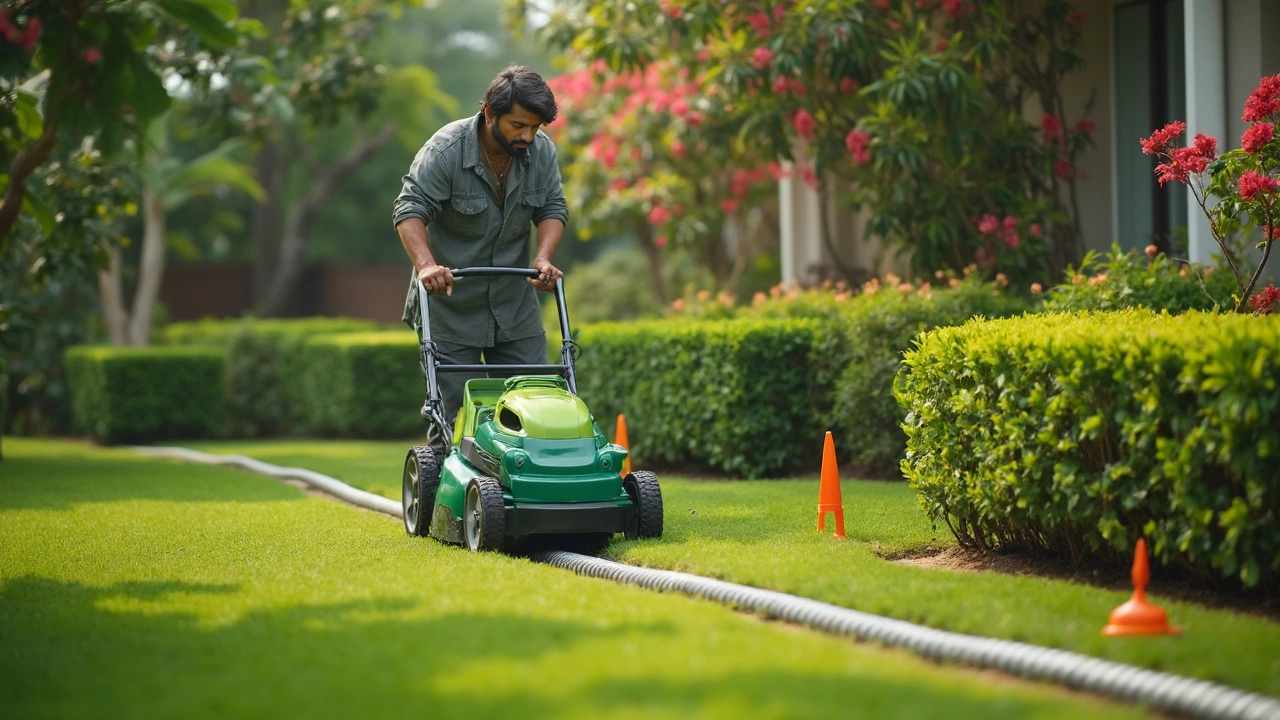If you've got drip irrigation tucked under your lawn, it's tempting to just mow right over it and forget it's even there. But let’s be real—plastic lines aren’t magic. They do a great job watering right at the roots and keeping your yard green, but mower blades and heavy wheels? Not their best friends.
Some folks have tried to wing it, thinking those black tubes are tough enough. They usually find out the hard way with a quick spray of water and a patch of dead grass later on. The good news is, you don’t have to choose between a perfect lawn and a working drip system. A bit of know-how goes a long way here.
- How Drip Irrigation Lines Work in Lawns
- What Happens if You Mow Over Drip Lines?
- Smart Ways to Protect Your System
- Best Practices for Mowing With Drip Irrigation
How Drip Irrigation Lines Work in Lawns
Drip irrigation works differently from the usual sprinklers most folks are used to. Instead of spraying water everywhere, these systems deliver water straight to the roots through long, thin tubes. You usually find these tubes set a couple of inches below the surface or just under the mulch—right where the grass or roots can soak it up fast.
Here’s how the setup usually breaks down:
- The main line connects to your water source or a timer, giving you control over when and how much your lawn drinks.
- Secondary lines, called laterals, branch off and snake around the yard in a sort of grid. They’ve got tiny holes, or emitters, that slowly drip water right into the soil.
- Filter and pressure regulators keep the water clean and flowing slow—too much pressure can pop emitters out or damage pipes.
- The lines are usually made of flexible black polyethylene, which is strong but not invincible. Sharp stuff (like mower blades) or digging can tear them up.
One thing people do appreciate is that drip irrigation saves a lot of water. Studies show you can use up to 50% less water than with regular sprinklers, since there’s barely any lost to wind or evaporation.
| System Type | Water Savings | Efficiency |
|---|---|---|
| Drip Irrigation | Up to 50% | Over 90% |
| Sprinkler | Low or None | About 65%-75% |
Installing drip lines the right way matters. Going too shallow makes them easy to nick with a shovel, aerator, or mower. Too deep, and the roots don’t get hydrated quick enough, especially during hot summer days. Most pros bury them 2 to 6 inches deep for lawns, keeping them below daily yard activity but close enough for roots to benefit.
What Happens if You Mow Over Drip Lines?
Running a mower over drip lines sounds quick and easy, but you’re actually gambling with your whole watering setup. Drip irrigation lines are usually made from polyethylene, which won’t stand up to metal blades or even the pressure of heavy wheels for long.
Accidentally slicing into a line is all too common. When that happens, water leaks pop up, sections of grass miss out on watering, and suddenly you’re patching lines instead of enjoying your yard. Replacement can get pricy fast, especially if you have to keep raiding the hardware store for fix-it kits.
Here’s what you might run into if you mow right over those lines:
- drip irrigation pipes can split or get pinched, stopping water flow to whole areas
- Spray heads and emitters can break off or get clogged with soil and debris kicked up by the mower
- Small nicks in lines turn into big leaks within a week or two
- Don’t forget about safety: Water spurting onto electric mowers is a real shock risk
Damage isn’t rare. In fact, a study from Texas A&M found that about 18% of home irrigation repairs are from lawn equipment accidents. And if you’re rocking a riding mower, those big tires actually compress the shallow soil, sometimes crushing lines without cutting them. You end up with invisible problems you won’t notice until dry patches appear.
| Problem | How Often It Happens | Typical Repair Cost |
|---|---|---|
| Sliced line | Common | $10 - $50 |
| Crushed but not cut line | Regular | $0 (but lowers system life) |
| Broken emitter or head | Frequent | $5 - $20 each |
So, mowing over drip lines is a shortcut with long-term headaches. You’ll be saving time on one end just to spend it (and probably more money) fixing stuff later. No one wants to guess where lines are buried or babysit leaks all season.

Smart Ways to Protect Your System
So you want to keep your drip irrigation doing its job and your mower running without hiccups? Here’s the fix: planning and a few cheap tricks will save headaches (and money) later. Most pro landscapers say the biggest mistake people make is laying drip lines too close to the surface or right where mower wheels commonly travel.
“Every year, we see countless homeowners call for repairs after slicing through drip tubing with a mower. The best thing you can do is bury the lines at least 4 to 6 inches deep,” says Mike Daniels, owner of GreenPath Irrigation.
That’s not just his opinion. A survey by The Irrigation Association found that nearly 60% of accidental drip line damage comes from lawn equipment, not tree roots or pets.
| Protection Step | Estimated Cost ($) | Effectiveness Rating (1-5) |
|---|---|---|
| Bury lines 6 inches deep | 0 (if DIY) | 5 |
| Use solid-core tubing | 20 per roll | 4 |
| Mark with flags/stakes | 5 per pack | 3 |
| Install protective conduit | 15 per section | 5 |
Ready for a few quick tips?
- If your lines are already in, try marking them with flags or colored stakes, at least until you know the mower route by heart. Even a cheap pack from the hardware store works.
- If you’re starting from scratch, dig your trenches a little deeper than you think you need—aim for about 6 inches. That’s deep enough to dodge most mower blades and wheels.
- Run tubing parallel to straight mower lines instead of zig-zagging, so there’s less chance you’ll forget where tubes are hiding.
- Consider slipping drip lines inside a length of PVC pipe where they cross open areas or high-traffic zones. That way, even if you hit them, you’ll just ding the pipe, not the water line inside.
Most damage happens because people rush installations or don’t double-check where the lines run. Take an extra hour. Your lawn and your stress levels will thank you.
Best Practices for Mowing With Drip Irrigation
You want a well-watered lawn and a trouble-free mow? Make your life easier with a bit of planning. First off, always know exactly where your drip irrigation lines are. Snap a photo or make a quick sketch when you install them. Think future-you mowing on a sweaty Saturday, cursing a hidden pipe—don’t let that happen.
Depth is a big deal. If you're setting up your system, bury those lines at least 4 to 6 inches deep. Shallow pipes are asking for trouble; that blade will find them eventually. Already have exposed tubing? Get some lawn staples—cheap and easy. Anchor the pipes flat to the dirt before the next mow so the mower doesn’t suck them up or chop them.
It helps to flag your drip zones the first few times you mow. Little colored flags or even popsicle sticks work fine. Once you’ve got things mapped out and the grass filled in, you can ditch the flags.
If you're still worrying about accidents, switch to a rotary mower instead of a reel mower. Rotary blades won’t dig as deeply if you bump a raised area. Oh, and check your tire pressure. Heavy mowers can press exposed pipes into the dirt, which sounds good until you realize it can squeeze the water flow shut or actually snap a tube.
If you ever hear a weird crunch or see water pooling after mowing, stop and check your system. Quick repairs save the rest of your lawn from drying out. Some folks keep a cheap drip repair kit in the garage for these moments—smart move.
Sticking to these habits means you’ll spend less time fixing and more time kicking back on a lawn that looks great and works for you, not against you.





